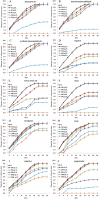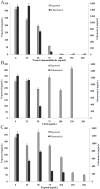Inhibitory effect of essential oils on Aspergillus ochraceus growth and ochratoxin A production
- PMID: 25255251
- PMCID: PMC4178002
- DOI: 10.1371/journal.pone.0108285
Inhibitory effect of essential oils on Aspergillus ochraceus growth and ochratoxin A production
Abstract
Ochratoxin A (OTA) is a mycotoxin which is a common contaminant in grains during storage. Aspergillus ochraceus is the most common producer of OTA. Essential oils play a crucial role as a biocontrol in the reduction of fungal contamination. Essential oils namely natural cinnamaldehyde, cinnamon oil, synthetic cinnamaldehyde, Litsea citrate oil, citral, eugenol, peppermint, eucalyptus, anise and camphor oils, were tested for their efficacy against A. ochraceus growth and OTA production by fumigation and contact assays. Natural cinnamaldehyde proved to be the most effective against A. ochraceus when compared to other oils. Complete fungal growth inhibition was obtained at 150-250 µL/L with fumigation and 250-500 µL/L with contact assays for cinnamon oil, natural and synthetic cinnamaldehyde, L. citrate oil and citral. Essential oils had an impact on the ergosterol biosynthesis and OTA production. Complete inhibition of ergosterol biosynthesis was observed at ≥ 100 µg/mL of natural cinnamaldehyde and at 200 µg/mL of citral, but total inhibition was not observed at 200 µg/mL of eugenol. But, citral and eugenol could inhibit the OTA production at ≥ 75 µg/mL and ≥ 150 µg/mL respectively, while natural cinnamaldehyde couldn't fully inhibit OTA production at ≤ 200 µg/mL. The inhibition of OTA by natural cinnamaldehyde is mainly due to the reduction in fungal biomass. However, citral and eugenol could significant inhibit the OTA biosynthetic pathway. Also, we observed that cinnamaldehyde was converted to cinnamic alcohol by A. ochraceus, suggesting that the antimicrobial activity of cinnamaldehyde was mainly attributed to its carbonyl aldehyde group. The study concludes that natural cinnamaldehyde, citral and eugenol could be potential biocontrol agents against OTA contamination in storage grains.
Conflict of interest statement
Figures





Similar articles
-
Effect of Cinnamaldehyde on Morphological Alterations of Aspergillus ochraceus and Expression of Key Genes Involved in Ochratoxin A Biosynthesis.Toxins (Basel). 2018 Aug 22;10(9):340. doi: 10.3390/toxins10090340. Toxins (Basel). 2018. PMID: 30135391 Free PMC article.
-
iTRAQ proteome analysis of the antifungal mechanism of citral on mycelial growth and OTA production in Aspergillus ochraceus.J Sci Food Agric. 2021 Sep;101(12):4969-4979. doi: 10.1002/jsfa.11140. Epub 2021 Feb 25. J Sci Food Agric. 2021. PMID: 33543481
-
Risk management of ochratoxigenic fungi and ochratoxin A in maize grains by bioactive EVOH films containing individual components of some essential oils.Int J Food Microbiol. 2018 Mar 23;269:107-119. doi: 10.1016/j.ijfoodmicro.2018.02.002. Epub 2018 Feb 3. Int J Food Microbiol. 2018. PMID: 29421354
-
Ecophysiology of ochratoxigenic Aspergillus ochraceus and Penicillium verrucosum isolates. Predictive models for fungal spoilage prevention - a review.Food Addit Contam. 2006 Apr;23(4):398-410. doi: 10.1080/02652030500376102. Food Addit Contam. 2006. PMID: 16546886 Review.
-
A Comparative Review of Eugenol and Citral Anticandidal Mechanisms: Partners in Crimes Against Fungi.Molecules. 2024 Nov 23;29(23):5536. doi: 10.3390/molecules29235536. Molecules. 2024. PMID: 39683696 Free PMC article. Review.
Cited by
-
The AFLATOX® Project: Approaching the Development of New Generation, Natural-Based Compounds for the Containment of the Mycotoxigenic Phytopathogen Aspergillus flavus and Aflatoxin Contamination.Int J Mol Sci. 2021 Apr 26;22(9):4520. doi: 10.3390/ijms22094520. Int J Mol Sci. 2021. PMID: 33926042 Free PMC article.
-
The anti-aflatoxigenic mechanism of cinnamaldehyde in Aspergillus flavus.Sci Rep. 2019 Jul 19;9(1):10499. doi: 10.1038/s41598-019-47003-z. Sci Rep. 2019. PMID: 31324857 Free PMC article.
-
The Inhibitory Effect of Pseudomonas stutzeri YM6 on Aspergillus flavus Growth and Aflatoxins Production by the Production of Volatile Dimethyl Trisulfide.Toxins (Basel). 2022 Nov 11;14(11):788. doi: 10.3390/toxins14110788. Toxins (Basel). 2022. PMID: 36422962 Free PMC article.
-
In vitro and in vivo anti-Candida activity of citral in combination with fluconazole.J Oral Microbiol. 2022 Mar 2;14(1):2045813. doi: 10.1080/20002297.2022.2045813. eCollection 2022. J Oral Microbiol. 2022. PMID: 35251524 Free PMC article.
-
Antimycotic Effects of 11 Essential Oil Components and Their Combinations on 13 Food Spoilage Yeasts and Molds.J Fungi (Basel). 2021 Oct 16;7(10):872. doi: 10.3390/jof7100872. J Fungi (Basel). 2021. PMID: 34682293 Free PMC article.
References
-
- Pardo E, Marín S, Ramos A, Sanchis V (2006) Ecophysiology of ochratoxigenic Aspergillus ochraceus and Penicillium verrucosum isolates. Predictive models for fungal spoilage prevention–a review. Food Addit Contam A 23: 398–410. - PubMed
-
- Hocking AD, Leong SL, Kazi BA, Emmett RW, Scott ES (2007) Fungi and mycotoxins in vineyards and grape products. Int J Food Microbiol 119: 84–88. - PubMed
-
- Bayman P, Baker JL (2006) Ochratoxins: a global perspective. Mycopathologia 162: 215–223. - PubMed
-
- Sokolić-Mihalak D, Frece J, Slavica A, Delaš F, Pavlović H, et al. (2012) The effects of wild thyme (Thymus Serpyllum L.) essential oil components against ochratoxin-producing Aspergilli . Arch Indust Hygiene Toxicol 63: 457–462. - PubMed
Publication types
MeSH terms
Substances
LinkOut - more resources
Full Text Sources
Other Literature Sources

